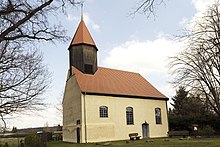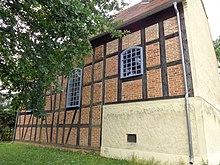Mummies from Illmersdorf
The Illmersdorf mummies are eleven mummified corpses, eight adults and two children as well as an infant, in ten coffins in the mummy tomb of the half-timbered church in Illmersdorf near Drebkau in Brandenburg . The mummies were created without using artificial mummification processes . Experts suspect that the bodies dried up and became mummified. Today the mummies from the period 1748 to 1821 are a tourist attraction. Five of the eleven mummies can be viewed through a pane of glass. The Illmersdorf mummies are the only ones in Lusatia and are considered the largest mummy treasure in Brandenburg.
history
Gut Illmersdorf owned by the Normann family
According to the local chronicle, Caspar Ernst von Normann, a colonel sergeant from the Rothenburg Grenadier Regiment and member of an ancient nobility on the island of Rügen , bought the Illmersdorf estate in 1738. The von Normann family is an old Pomeranian-Rügen noble family that was first mentioned in the 13th century in the Principality of Rügen. Four years after the purchase, he built a new church in the village in place of the manor chapel in 1742. Under the gallery of the small church he had a crypt (7.80 × 3.10 × 2.30 m) set up for himself and his wife, Johanna Louise, née von Barfus . The alliance coat of arms of both families is above the west door, a second coat of arms in the church. His coat of arms on the outside of the west wall bears the inscription: "With God's help, Caspar Ernst von Normann had this church built MDCCXLII Royal Prussian Colonel Sergeant of the Cavalry"
Only six years after completion, the builder himself was buried here in 1748. In the period from 1748 to 1821, the deceased were buried here in a total of eight large and two small coffins. There are eleven mummies inside: five women, three men, two children and an infant. The builder's daughter-in-law died giving birth and was buried with the baby in a coffin. All corpses were mummified because the crypt was well ventilated and dry. Through an opening in the wall, the constant draft of air was able to dry out the corpses and thus mummify them before they started to rot . In 1794 the church was rebuilt. An inscription cartouche in the central arch of the west gallery above says:
- "1794 from Royal Prussia. Captain Wilhelm Erdmann v. Normann white the church and have this choir built. "
In 1843 the von Normann family sold their manor.
Time after the Normann family
In 1930 the church was renovated. Originally there were also grave goods in the coffins , as older locals tell. However, these were presumably looted after the Second World War at the latest . Red Army soldiers looted the grave goods in 1945 and residents were able to prevent the coffins from being burned in the village square. During the GDR era, the place and the church were threatened with demolition for the expansion of the opencast mines in the Lusatian lignite mining area . So the church slowly fell into disrepair.
After the turn of 1989 the demolition of the village was no longer necessary and the church was restored in 1996 for the equivalent of 409,000 euros. During the restoration of the mummies in the crypt, very high levels of mold appeared. In May 2001 the church received a new roof. In 2002 the church and crypt were reopened. Now only four coffins with five mummies behind a pane of glass can be viewed. It concerns the builder of the church, his son, his mother and his daughter-in-law with their dead baby. The protective glass pane enables the maintenance of a uniform dry climate and is intended to prevent the ingress of fungi that could destroy the mummies. Six other coffins are closed in the crypt, the parish and the small town lack the money for cleaning the mummies and their colorful festive robes.
In 2013 around 1500 visitors visited the mummies of Illmersdorf and the listed half-timbered church.
People in the mummy tomb
Several mummified persons are not known by name. Only one of the ten coffins has the name and the dates on the cover inscription:
- “Here in God rests Mrs. Caroline Louise von Schönbergs, born of Normann born. March 3rd, 1740 died April 17th, 1821. You will be unforgettable to us. "
| Surname | birth | death | annotation |
|---|---|---|---|
| Caspar Ernst von Normann | 1696 | 1748 | He was the builder of the church with a tomb and a very strong man during his lifetime. |
| Ulrike Eleonore von Normann | 1736 | 1765 | Born von Rieben was the builder's daughter-in-law. She died while giving birth to her child (stillborn), who was buried next to her in the coffin (only the head can be seen). She was probably buried in a wedding dress , a so-called " Watteau pleated dress " ( tied at the back). |
| Wilhelm Erdmann from Normann | 1734 | 1806 | Fourth son of the builder, royal Prussian Rittmeister , husband of Ulrike Eleonore von Rieben, brother of Caroline Luise von Schönberg; buried in his uniform, but with a house cap, weapons are missing (presumably looted) |
| Caroline Luise von Schönberg | 1740 | 1821 | Born von Normann (March 3, 1740 - April 17, 1821) was the daughter of the builder. Ribbons are stretched across her body. She was buried in April 1821. The statement that she was only supposed to have been dead and knocked on the inside of the coffin is unlikely and unproven . Her heirs - who had already divided the property among themselves - would have tied her up and then buried her. Other explanations are that corpses after the onset of rigor mortis were placed in the coffin, are often tied together with cords had so they lay properly, or that they were simply transport security. |
| Johanna Louise von Normann | Born von Barfus was the wife of the builder. | ||
| Juliane Helena from Normann | born from Rieben |
literature
- Andreas von Scheven: Illmersdorf. The mummy tomb - a special burial place in the state of Brandenburg. In: Brandenburg Monument Preservation. Volume 16, issue 2/2007.
Web links
- Church Illmersdorf , official website of the parish
- Die Welt: Picture of the exhibited mummies in Illmersdorf ( Memento from June 11, 2015 in the Internet Archive )
Individual evidence
- ↑ a b c d e f g h Andreas von Scheven: Illmersdorf. The mummy tomb - a special burial place in the state of Brandenburg . In: Brandenburg Monument Preservation . No. 2 , 2007, p. 28-42 .
- ↑ a b c d Kai Biermann: Knocked on the coffin from the inside . In: Berliner Zeitung . December 14, 1999 ( berliner-zeitung.de ).
- ↑ a b c New roof over old mummy . In: Berliner Zeitung . April 2, 2001 ( berliner-zeitung.de ).
- ↑ a b Environment: Saunadorf van Almsick. Retrieved January 13, 2015 .
- ↑ a b leaflet: Illmersdorf greets its guests.
- ↑ a b Mummies A mysterious journey through East German tombs. 3Sat, November 1, 2011, accessed January 12, 2015 .
- ↑ Manuel Hirsch: Germany also has its mummies . In: Pattaya Blatt . October 13, 2013 ( pattayablatt.com ).
- ↑ a b c Mummies and scary stories . ( tagesspiegel.de ).
- ^ Kramer G., Wildführ W .: Mold investigations in the crypt of the village church in Illmersdorf (Brandenburg). In: 7th Congress of the Society for Hygiene and Environmental Medicine (GHU), Leipzig, March 1999 . March 1999.
- ↑ a b c Ronald Ufer: And after the Sunday roast in the crypt . In: Lausitzer Rundschau . May 7, 2004 ( lr-online.de ).
- ↑ Ronald Ufer: At the weekend it's mummy time again in Illmersdorf . In: Lausitzer Rundschau . April 18, 2005 ( lr-online.de ).
- ^ Image of the mummies with explanatory text in the church from 4th IGBCE bicycle tour June 12, 2005 by Thomas Schulze. Retrieved January 13, 2015 .
- ↑ Kai Michel: And the dead do talk . 140 mummies lie in a crypt in the Berlin underground. A research team is investigating their history. In: Zeit Online . 2003 ( zeit.de ).
Coordinates: 51 ° 41 ′ 38.3 " N , 14 ° 10 ′ 32.1" E

